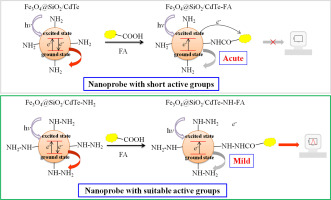Journal of Inorganic Biochemistry ( IF 3.8 ) Pub Date : 2018-06-15 , DOI: 10.1016/j.jinorgbio.2018.06.003 Min Wang , Xiaofang Fei , Shaowu Lv , Ye Sheng , Haifeng Zou , Yanhua Song , Fei Yan , Qianlong Zhu , Keyan Zheng

|
In this study, we designed and synthesized two novel fluorescent magnetic nanoparticles. Fe3O4@SiO2-NH-GSH-CdTe (FSGC) (GSH = glutathione) nanoparticles were synthesized using amino-functionalized Fe3O4@SiO2 nanoparticles and GSH-stabilized CdTe quantum dots (CdTe QDs), while flexible Fe3O4@SiO2-NH-GSH-CdTe-NH-NH2 (FSGCN) nanoparticles were synthesized using the FSGC precursor and 1,6-hexamethylenediamine. These two kinds of nanoprobes exhibited excellent magnetic and fluorescent properties. By comparing the fluorescence quenching effect of folic acid (FA) on FSGC and FSGCN, we found that the quenching effect of FA on FSGC was acute and the process was too fast to determine the FA content. However, the quenching effect of FA on flexible FSGCN was mild and hence it could be used as a nanoprobe to determine FA concentration. At physiological pH, the fluorescence quenching effect of FA on the FSGCN nanoprobes was fitted according to the Stern–Volmer equation with a linear response in the concentration range of 0.14 to 4.20 μg mL−1 with a detection limit of 15.1 × 10−9 g mL−1 (S/N = 3) under optimized experimental conditions. The proposed flexible nanoprobe was successfully used to determine the content of FA in folic acid tablets. Recovery was found to be in the range of 92.7%–105.6% with a relative standard deviation of 1.12%–3.84%. Owing to their good stability, environment-friendly characteristics, high selectivity, and good optical properties and biocompatibility, these nanoprobes have potential for usage in practical applications.
中文翻译:

柔性荧光磁性Fe 3 O 4 @SiO 2 / CdTe-NH 2纳米探针的合成与表征
在这项研究中,我们设计并合成了两种新型的荧光磁性纳米粒子。使用氨基官能化的Fe 3 O 4 @SiO 2纳米颗粒和GSH稳定的CdTe量子点(CdTe QDs)合成了Fe 3 O 4 @SiO 2 -NH-GSH-CdTe(FSGC)(GSH =谷胱甘肽)纳米颗粒Fe 3 O 4 @SiO 2 -NH-GSH-CdTe-NH-NH 2(FSGCN)纳米粒子是使用FSGC前体和1,6-六亚甲基二胺合成的。这两种纳米探针表现出优异的磁性和荧光性质。通过比较叶酸(FA)对FSGC和FSGCN的荧光猝灭作用,我们发现FA对FSGC的猝灭作用是急性的,并且该过程太快而无法确定FA含量。但是,FA对柔性FSGCN的淬灭作用温和,因此可以用作确定FA浓度的纳米探针。在生理pH值下,根据Stern–Volmer方程拟合FA对FSGCN纳米探针的荧光猝灭效果,其线性响应在0.14至4.20μgmL -1的浓度范围内,检出限为15.1×10 -9 g毫升-1(S / N = 3)在最佳实验条件下。所提出的柔性纳米探针已成功用于测定叶酸片剂中FA的含量。回收率在92.7%–105.6%范围内,相对标准偏差为1.12%–3.84%。由于其良好的稳定性,环境友好的特性,高的选择性以及良好的光学性能和生物相容性,这些纳米探针具有在实际应用中使用的潜力。











































 京公网安备 11010802027423号
京公网安备 11010802027423号